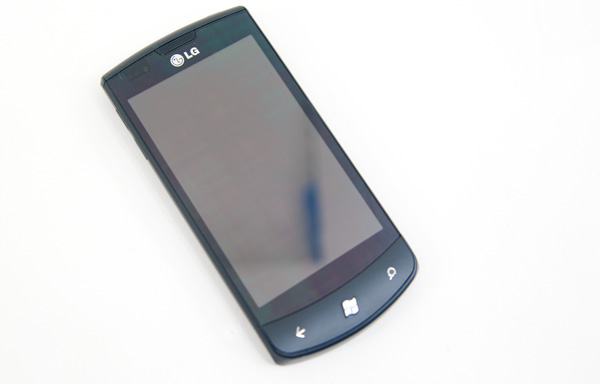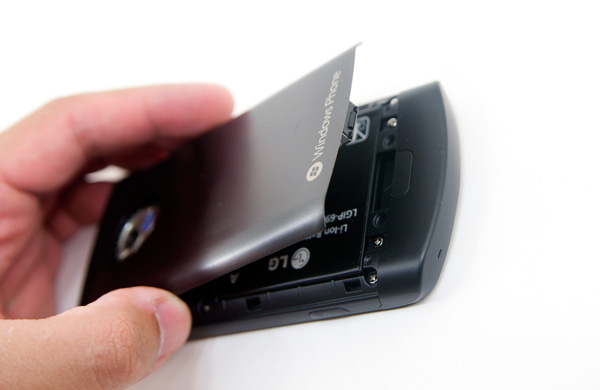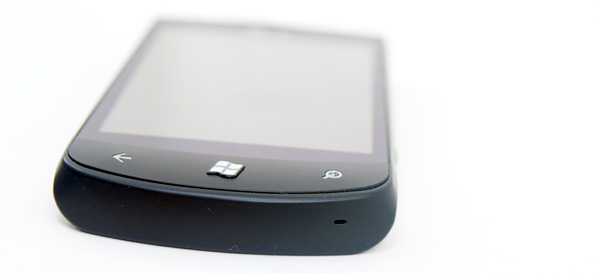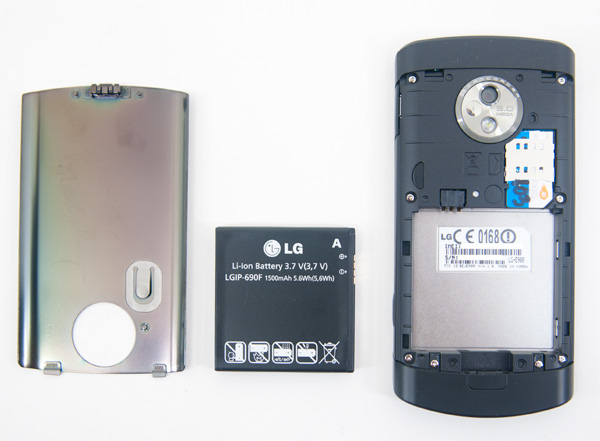LG's Optimus 7 & Samsung's Focus Reviewed: A Tale of Two Windows Phones
by Anand Lal Shimpi on December 3, 2010 10:14 PM EST- Posted in
- Smartphones
- Samsung
- Windows Phone 7
- LG Optimus
- LG
- Samsung Focus
- Mobile
The LG Optimus 7
The Optimus 7 is the first LG phone we've ever looked at. In fact, it's the first device we've received directly from LG. I will say that out of all of the smartphone makers, LG is at least the most forthright about its products. We got very little marketing associated with the phone, just blunt statements about what it is and what it isn't:
"Look, you already know Microsoft has put some very strict guidelines on the hardware for these smartphones so the challenge from the start was how to physically stand out in a field where specs are going to be virtually the same.
Optimus 7 has a couple points we're quite proud of, namely:
1) 1,500mAh user-replaceable battery
2) 16GB memory
3) Solid and substantial "feel"
But we recognize hardware differences aren't enough to stand out among more-than-capable competitors like Samsung and HTC. The user experience is what we think will separate one device from the next in the WP7 world.
And in this regards, we think we have a solid strategy of delivering software solutions which are unique to just our WP7 device:
1) Play To
2) Scan Search
3) Voice to Text for SMS
And we're proud of the fact that we don't load Optimus 7 with a lot of "LG apps" or a fancy animated UI which gets old in a few weeks. :-)
But Optimus 7 isn't "optimal" in all aspects, either. Maybe we should have offered a bigger screen. Which isn't to say we don't think 3.8" isn't big enough, we think it's a good trade-off for usability and long battery life. But you know how people react when they see a 3.8" next to a 4.3".
Well, it's our first attempt, I'm sure we'll learn a lot from this experience."
I have to say, if all companies behaved like LG I might just be out of a job. Other than the screen, LG's assessment of its own phone is shockingly accurate.
It does have a solid and substantial feel to it, the Optimus 7 is very well built. Weighing in at 157g, it has all of the weight of the iPhone 4, plus a bit extra. It's not what I'd consider too heavy, just hefty.
The weight is all in the materials. You get a solid metal housing and a brushed aluminum backplate. The back cover is spring loaded; press down on the release button and it'll pop up slightly.
The Focus is thin and wide. I appreciate the thickness but I'd prefer it if Samsung opted for a narrower design. LG on the other hand I believe got the form factor down pat. A lot of this is personal preference, but I do believe the sweet spot for Windows Phones may be around the 3.8-inch mark. All navigation elements in the OS are big enough where you don't need a huge screen to get around quickly. And the larger screen doesn't really add anything, particularly at the same resolution. I don't believe the same is true for Android phones, but for WP7 I don't believe bigger is necessarily better. Funny that the ideal Windows Phone size is very similar to the iPhone, given how similar Microsoft and Apple's OS design philosophies were.
LG opted for physical buttons on the Optimus 7. It's actually more like a really long rocker switch than three individual buttons, but it works well. You get confident feedback from every button push.
All Windows Phones must have a physical camera shutter release button. On the Optimus 7 this button protrudes more than I'd like. I found myself accidentally hitting the camera button while fumbling around with the phone.
As an aside, while I appreciate the requirement for a hardware shutter release, I do believe it's a mistake not to allow for a software capture button as well.
The battery is huge for the Optimus 7. The 3.8-inch HTC Surround has a 4.55Whr battery, while the 4.0-inch Super AMOLED Focus has a 5.55Whr battery. The Optimus 7 falls smack in the middle of those two. You get a 3.8-inch low power LCD display like the Surround but with the battery capacity of the larger Focus. As you may have already seen, the Optimus 7 delivers the longest web browsing battery life of any of the three Windows Phone 7 devices we've tested thus far.
The Optimus 7 ships with 16GB of internal NAND and there's no user accessible microSD slot to change things. The larger NAND capacity does work well on WP7 because of how media-focused the OS is. It arguably provides a better audio/video playback experience than the iPhone.
I'll get to the software in a moment, but LG does ship some of the more useful apps I've seen from a Windows Phone 7 OEM.
Unfortunately the Optimus 7 isn't headed for any carriers in the US. It's available in Canada, Europe and Asia.














34 Comments
View All Comments
omega12 - Friday, December 3, 2010 - link
"Apple is the first company I've seen to take the pace of innovation offered by Moore's Law and pair it with an equally aggressive expected upgrade cycle."Last time i checked their hardware was not exactly up to date so I don't think you can say they are the kind that follows Moore's Law closely. Aggressive upgrade cycle they do have though.
Maybe you meant that with each upgrade they usually change their core hardware? But then again that's hardly the case. I don't get it.
sprockkets - Friday, December 3, 2010 - link
I think Moore and his law need to die. This isn't even cpus we are talking about, and Anand even referenced the stupid law when referring to SSDs.For that matter, if they really were following Moore's law they would upgrade like every 18 months, not 12, and others upgrade like every 6 months. And those ARM cpus are not getting upgrades solely based on litho process improvements either.
foolsgambit11 - Monday, December 6, 2010 - link
Moore's Law is often used a simple shorthand for referring to the rapid pace of technological innovation, and that's how it was used here. But given that, Moore's Law originally only said that the number of transistors that can be fit on a given size of silicon will double roughly every 18-24 months (Moore used different numbers at different times). So it applies equally well to SSDs.Anand Lal Shimpi - Friday, December 3, 2010 - link
I meant from an end user standpoint. The typical PC upgrade cycle is 3 - 5 years, Apple's sales strategy seems to be to shorten that cycle fairly aggressively.The holy grail a decade ago was selling PCs like cars - a new one every model year. Apple has effectively done that. It's great for Apple's bottom line for sure.
Take care,
Anand
StormyParis - Saturday, December 4, 2010 - link
Indeed, the car model-year explanation makes a lot more sense. People like getting stuff that is "new", it's an easy-to-grok upgrade cycle, and, thanks to technological progress, PC model-years mean more than cosmetics changes, which are what most car model-years are about.I'm wondering why most brands don't go with the yearly line-up refresh, probably towards the end of summer. I'm guessing PC companies still mainly see themselves as tech-driven, or even component-driven, which kinda explains why Apple is making a killing.
Pirks - Sunday, December 5, 2010 - link
"why most brands don't go with the yearly line-up refresh, probably towards the end of summer"That's because most brands are run by the Mototrolls and frobitches of the world.
wyvernknight - Monday, December 6, 2010 - link
Wow, its pirks, the persistent apple-lover from dailytech. Long time since i read one of your comments!Exelius - Monday, December 6, 2010 - link
Apple's hardware was pretty up to date when it was released; which was quite a while ago. The trick for Apple is that they underclock everything to achieve excellent battery life.Mobile hardware goes out of date pretty quickly; but I still wouldn't say the iPhone 4 is exactly ancient. They release one hardware upgrade and several software upgrades per year.
If you mean stuff other than the iPhone, then sure. But I'm not really sure they need to be the latest-and-greatest; the MBP is still easily the best selling laptop in the world and when you compare the MBP to truly comparable laptops, it's not poorly priced. Try to find a laptop with high-res, quality 15" screen, discrete switchable GPU, i5 or i7 and 5+ hours battery life... The entire package is what's important.
It's almost to Apple's advantage to sell slightly out-of-date components, so you buy a new one every year... Compare this with a company like Dell, HP or Acer where they release a new product every week, so the end-users know that whenever they want to upgrade, there will be a new product there for them to buy. With Apple, you try to time your purchase right after a major announcement.
mfenn - Friday, December 3, 2010 - link
The Youtube video on page 9 is marked as private. :(tipoo - Saturday, December 4, 2010 - link
Works fine for me, but not in the embedded player. You have to double click it to open it in youtube.